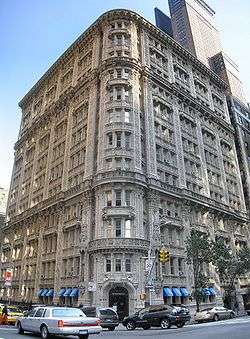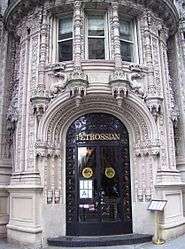Alwyn Court
The Alwyn Court is a 12-story apartment building located at 180 West 58th Street on the corner of Seventh Avenue in Midtown Manhattan, New York City, one block south of Central Park. It was built between 1907 and 1909, and was designed by Harde & Short in French Renaissance style, with elaborate terra-cotta ornamentation in the Francis I style covering the entire facade.[2] The octagonal, multi-story interior courtyard has a painted architectural façade (1977-1982) that was executed by artist Richard Haas.[3][4]
Alwyn Court | |
 (2007) | |
   | |
| Location | 180 W. 58th St. Manhattan, New York City |
|---|---|
| Coordinates | 40°45′57″N 73°58′46″W |
| Built | 1907 |
| Architect | Harde & Short |
| Architectural style | French Renaissance |
| NRHP reference No. | 79001599[1] |
| Significant dates | |
| Added to NRHP | December 26, 1979 |
| Designated NYCL | June 7, 1966 |
The building was constructed at a time when wealthy New Yorkers, some living in the city part-time, began to shift from mansions to apartment living. Seventh Avenue was a hub of new luxury buildings. The Alwyn targeted this market, with perhaps the most lavish structure yet. Glazed terra cotta was a new material, and the facade dripped with ornate detail in that medium. Typical apartments had 14 rooms with 5 bathrooms, renting up to $10,000 per year; there was even one 24-room duplex, at $22,000. Many of the apartments had enormous rooms of about 18 by 30 feet.[5][6] The twelfth floor contained 34 rooms for servants quarters.[7][8]
The building predated fire codes. There were no fire escapes, and there was a single staircase, which, open to the entire building, created a potential fire chimney. In 1910, with building still mostly unrented, a fire broke out in an empty apartment on the tenth floor, and flames jumped along the exterior to set the apartments above it ablaze.[9] According to the Tribune, 10,000 people gathered to watch the fire. Casualties were few and minor, and the damage was quickly repaired.[5]
By the 1930s, the city's architectural and social landscape had changed, and the Alwyn was no longer in a desirable part of town. Only about a quarter of the apartments were occupied, and the owners were unable to pay the mortgage. The building was foreclosed, gutted, and subdivided during the Depression.[2][5][10] When the building reopened in the fall of 1938, after the renovations, an advertisement in The New Yorker noted that Dorothy Draper Inc., a Manhattan firm founded by interior decorator Dorothy Draper, had overseen the remodeling, which included a redecorated lobby and elaborate, still-extant plaster medallions on the ceilings of the public corridors. Although the interior has changed over time, the exterior, with its intricate terra-cotta decoration, has largely remained unchanged.
The Alwyn Court was designated a New York landmark in 1966, and added to the National Register of Historic Places in 1979. The facade was cleaned and restored in 1980-81 by Beyer Blinder Belle,[3] but was still in poor shape, endangering passersby in the late 1990s, necessitating the erection of a sidewalk shed.[5]
Gallery
 Entrance to Petrossian
Entrance to Petrossian Detail over doorway
Detail over doorway
See also
- Harde & Short, architectural firm
- Red House (Manhattan)
- Alwyn, given name, including people with the name
References
Notes
- "National Register Information System". National Register of Historic Places. National Park Service. March 13, 2009.
- New York City Landmarks Preservation Commission; Dolkart, Andrew S.; Postal, Matthew A. (2009). Postal, Matthew A. (ed.). Guide to New York City Landmarks (4th ed.). New York: John Wiley & Sons. ISBN 978-0-470-28963-1., p.126
- White, Norval & Willensky, Elliot (2000). AIA Guide to New York City (4th ed.). New York: Three Rivers Press. ISBN 978-0-8129-3107-5., p.269
- https://www.culturenow.org/index.php?page=entry&permalink=03695&seo=Alwyn-Court-Atrium-Murals_Richard-Haas
- Gray, Christopher (1997-04-06). "The Lavish 'Studio Palace' Called Alwyn Court". The New York Times. ISSN 0362-4331. Retrieved 2018-05-02.
- "New York Flat Fire Thrills - Maid Saved by Ledge When She Leaps from Thirteenth Floor". Chicago Tribune (published 1910-03-05). 1910-03-04. Retrieved 2018-05-02 – via Newspapers.com

- "Alwyn Court Afire; Maids Aid in Rescue – Wertheim Children, Left Alone While Parents Were at Opera, Saved by Servants". The New York Times. 1910-03-05. ISSN 0362-4331. Retrieved 2018-05-02. Lay summary (PDF).
- "The Extravagant Life". The Evening Chronicle. 1910-01-31. Retrieved 2018-05-02 – via Newspapers.com.
- "New Plan to Fight Skyscraper Fires – Exterior High-Pressure Standpipes for All Tall Buildings Advocated by Expert – Present Means Inadequate – Superintendent of Underwriters Also Recommends Fire Escapes to Permit Firemen to Get at the Flames". The New York Times. 1910-04-08. ISSN 0362-4331. Retrieved 2018-05-02. Lay summary (PDF).
- Alpern, Andrew. Luxury Apartment Houses of Manhattan: An Illustrated History. New York: Dover, 1992.

